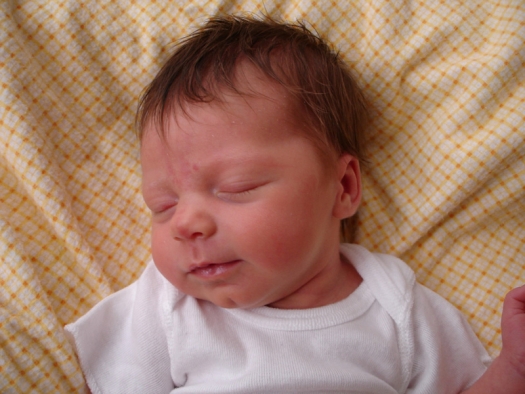Is the baby's bedding creating toxic nerve gases?
babysleeping.jpg

Photo by Jeff Terry, Copyright 2005 / freeimages.com
Babies sleep safer on their backs according to the Eunice Kennedy Shriver National Institute of Child Health and Human Development.
Research done over the last 22 years in Great Britain and New Zealand indicates that Sudden Infant Death Syndrome (SIDS) is an environmental poisoning in the crib.
In 1988, Barry Richardson, a British chemist specializing in deterioration and preservation of materials, and Peter Mitchell, a marquee specialist, were working on Mitchell's deteriorating marquee, awnings and party tents. Mitchell's marquee supplier told him that the chemicals in awnings and tents were the same chemicals that had been approved for use in baby mattresses. Mitchell also learned from Richardson that these same chemicals could be converted into nerve gas. Mitchell and Richardson decided maybe there was a connection here to SIDS.
The research by Richardson began immediately. The three chemicals of concern are phosphorus used in the baby mattress cover and arsenic and antimony added as preservatives and fire retardants. Richardson had determined that a common household fungus, Scopulariopsis brevicaulis, gets established in the mattress from the baby's sweating, spitting up and so on. Once established, the fungus begins to consume these three chemicals in the mattress. This results in the production of three nerve gases: phosphine, arsine and stibine, all of which can be very deadly, especially to infants.
In late 1988 Richardson asked local coroners to cooperate by releasing mattresses on which SIDS babies had died. He received 200 mattresses of all varieties: foam, plastic, fabric and netted. By June 1989 all the mattresses had been tested with the following results:
- Every mattress was infected with the S. brevicaulis fungus as an organism and/or spores.
- All mattresses had one or more of the chemicals phosphorus, arsenic or antimony.
- Each mattress generated one or more of the nerve gases (phosphine, arsine or stibine) when brought to blood/body temperature.
At this time, Richardson analyzed six blood samples of the SIDS babies who died on mattresses with antimony and found high levels of antimony in each sample. In addition, Richardson learned that 95% of the mattresses tested had been used by a previous baby.
Meanwhile in New Zealand, chemist T. J. Sprott, was questioning the role of chemicals in the baby's environment relating to SIDS. He learned of Richardson's research and concurred that nerve gas could also be poisoning babies in New Zealand. He established the guidelines for wrapping mattresses, known as the Cotlife 2000 Specifications. (For additional information visit Cot Life 2000.) These specifications involved wrapping the baby's mattress with a gas impermeable plastic to keep the gases from contaminating the sleeping area and, in addition, using cotton bedding. Since 1996, in New Zealand, 193,000 babies have slept on mattresses wrapped to these specifications. There have been no reported deaths on these wrapped mattresses.
SIDS is called the "mystery disease." Understanding the gas theory explains away the mystery by answering all of the following perplexing questions:
Q: Why do SIDS babies show no symptoms?
A: The lethal dose of nerve gas doesn't make them "ill." It acts by shutting down the nervous system, stopping heart function and breathing. Research has shown neuro-chemical deficits in SIDS babies that are consistent with poisoning by nerve gas.
Q: Why are babies at higher risk after illness or vaccination?
A: The fever that results increases the temperature in the crib environment. This stimulates fungus activity and nerve gas production tenfold or more.
Q: Why does the rate of crib death rise from one sibling to the next:
A: In a reused mattress, fungus established in prior use cause toxic gas generation to commence sooner and in greater volume.
Q: Why are babies at higher risk in families where births are close together?
A: Once again, the fungus in the mattress from the previous use will be quickly activated, producing gas sooner.
Q: Why are SIDS rates higher in the winter?
A: Windows are kept shut, allowing poor ventilation around the crib. Gases are less likely to dissipate. Babies are often bundled in blankets during the winter, trapping gases close to their bodies. Recent research shows the use of a fan in the baby's sleeping environment lowered the number of SIDS events.
Q: Why are babies sleeping face down at higher risk?
A: Stibine gas is formed from the interaction of the S. Brevicaulis fungus and the antimony in the mattress. This gas is very heavy and hangs right on the surface of the mattress. A baby sleeping face down will breathe this gas directly and is more likely to inhale a lethal dose. Arsine from antimony and phosphine from phosphorous are lighter, but still both heavier than air.
Q: Why are boy babies at higher risk for SIDS?
A: Most boys have a higher metabolic rate than girls, thus their body temperature can be somewhat higher than girls. The rate of gas generation increases rapidly with increasing temperature.
Q: Why does SIDS sometimes occur during bed-sharing on an adult mattress?
A: Phosphorus, arsenic and antimony can be found in most mattresses, allowing the generation of the nerve gases. Adults are not as susceptible to gas poisoning as infants.
Q: Why was SIDS rare before 1950?
A: Prior to 1950, harmful chemicals were not added to mattresses. It was postwar technology that prompted the common use of phosphorus as a plasticizer, arsenic as a preservative and antimony as a fire retardant. In England and Wales the SIDS statistics from 1953 onward increased in parallel with the increasing concentration of antimony in the mattress covers. In addition, prior to 1950 people commonly used soap for baby laundry, whereas now detergent and fabric softeners are common place. Detergent contains nitrogen and phosphorus compounds on which the fungus feeds.
Q: Why does SIDS generally occur between the ages of 2 months and 1 year?
A: It takes time for the fungus in the mattress to flourish and start generating gas. However, younger babies can die if they are sleeping on a mattress that has recently been used by an older sibling and has established, flourishing fungus. As babies get older, the gas exposure gives them a headache causing them to move around, wake their parents and stand up in their crib.
Q: Why is SIDS non-existent in some countries?
A: There used to be virtually no crib deaths in Japan. Japanese traditionally used untreated cotton futons for babies. Recently, Japan has started to adopt Western baby care practices, mattresses, etc., and the crib death rate has begun to rise. SIDS is practically non-existent in Russia, as well, where it is common to cover the mattress with rubber sheeting. This rubber is gas impermeable, inhibits fungal growth and is free of phosphorus, arsenic and antimony.
Q: Why have SIDS rates fallen over the past years?
A: The Back to Sleep campaign was introduced in 1994 encouraging parents to position their babies on their backs. This has likely saved many babies from stibine (the gas from antimony) poisoning. As was said earlier, this gas is heavy and hangs right on the surface of the mattress where face-down babies breathe it directly. However, babies sleeping on their backs are still exposed to the other nerve gases: arsine and phosphine. In a warm environment phosphine can be similar to the density of air and easily inhaled by a baby sleeping on its back. In addition, face up sleeping is not as effective in a cot or bassinet with enclosed sides, because the gases cannot flow away.
Q: What has the U.S. government done to address this issue?
A: Several years ago the U.S. government changed the mandate for chemicals required in baby mattresses. Many new mattresses currently do not have the arsenic and antimony in them. However, they are still using phosphorous to plasticize the mattress covering.
To prevent these nerve gases from reaching the baby, New Zealand Cotlife 2000 Specifications recommend doing all of the following:
- Cover the top, all sides, and most of the underside of the mattress with a polyethylene sheeting that is at least 5 mil thick and free of phosphorus, arsenic and antimony. Leave several venting holes on the underside of the mattress cover to allow the gas to escape. Stretch the sheeting tightly around the mattress to avoid bunching.
- Use Fleecy pure cotton mattress covers over the polyethylene sheeting and tuck it in securely. Make sure the covers have not been treated with flame retardant.
- Make the bed using pure cotton sheets and blankets.
- Do not use any of the following as baby bedding: sheepskin, moisture-resistant mattress protector, acrylic under blanket, sleeping bag or duvet.
- Clean mattress covers by wiping with pure soap and water. Do not use chemical bleaches or sterilizers.
- Ready made mattress covers can be purchased at Cot Life 2000, Babe Safe, and Harlow's Earth Waterproof Crib Mattress Covers.


